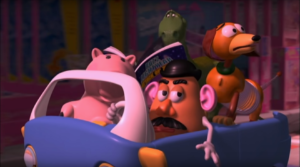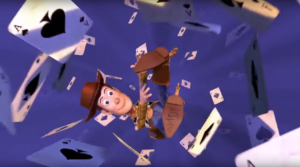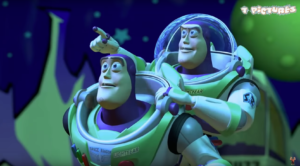Despite the lukewarm reaction to “A Bug’s Life,” everyone in 1999 was still riding the high that was “Toy Story.”
This movie not only pushed the envelope on how to create a great family film but it also single-handedly changed the way animated movies were made. With cutting-edge CG (computer graphics), strongly written characters and brilliant storytelling, Pixar started a revolution in the filmmaking business that we’re still seeing to this day.
With their first ever feature-length film, Pixar established themselves as the next big thing in cinema.
For a while, it felt like nothing could top “Toy Story.” However, all of that changed in the late nineties when Pixar released the follow-up to their beloved first film with “Toy Story 2.”
And, in my humble opinion, not only is “Toy Story 2” just as refined as the first one, I believe it surpasses the original with a stronger narrative, more complex characters and a massive contribution to the art of animation as a whole.
In order to fully grasp how imperative “Toy Story 2” is to Pixar’s rise to success, we must consider the state of Pixar at the time.
 When Pixar released the first teaser for “Toy Story 2,” people weren’t quite sure what to make of it.
When Pixar released the first teaser for “Toy Story 2,” people weren’t quite sure what to make of it.
At that time, Pixar had yet to establish its reputation. While “A Bug’s Life” was a financial success, it failed to capture the approval of several fans and critics and left many people contemplating whether or not Pixar had staying power.
So, when a sequel to “Toy Story” was announced, fans were both excited and nervous, and understandably so.
Typically, sequels tend not to be as refined as their predecessor. Despite this, people were still excited to see their favorite characters again.
The pressure was on for John Lasseter, founder of Pixar and director of “Toy Story,” and his team to put together a proper follow-up that would recapture the hearts of critics and show that they were there to stay. And they did so by producing what many consider the greatest of the “Toy Story” trilogy.
Now, it has come to my attention that I may be a little biased towards this movie as it was one of the first animated movies I saw as a kid.
However, upon further inspection, I believe it’s just as enjoyable (if not more) as an adult than it was when I was a kid.
 So, with all of the above in mind, let’s review the film’s plot (and oh boy, there’s a lot to unpack). The film opens up with Andy’s toys, Buzz Lightyear (Tim Allen) and Rex (Wallace Shawn), playing a video game on Andy’s Super Nintendo.
So, with all of the above in mind, let’s review the film’s plot (and oh boy, there’s a lot to unpack). The film opens up with Andy’s toys, Buzz Lightyear (Tim Allen) and Rex (Wallace Shawn), playing a video game on Andy’s Super Nintendo.
Meanwhile, Woody the cowboy doll (Tom Hanks) is preparing for his and Andy’s upcoming trip to cowboy camp, which is his only quality time with just him and Andy. However, things go array during Andy’s playtime when Woody’s arm becomes ripped.
Because of this, Andy decides to leave Woody behind as his mother makes the cutting remark that “toys don’t last forever.” This is such a gut-wrenching scene to view as the injured toy watches his owners drive away to cowboy camp without him.
This scene, along with the nightmare sequence that follows, gives us a terrifying glance inside the psyche of this little cowboy doll. In addition, the nightmare also lets the audience in on what Woody is afraid of the most, which comes into play later.
 Later that day, Woody wakes up to discover that Andy’s mom is running a yard sale, and an older toy, Wheezy the Penguin, is sadly being sold off.
Later that day, Woody wakes up to discover that Andy’s mom is running a yard sale, and an older toy, Wheezy the Penguin, is sadly being sold off.
Determined not to let this happen, Woody stealthily sneaks out to the front yard to rescue the periled penguin. While Wheezy is ultimately saved, Woody is unfortunately seized and stolen by a greedy toy store owner named Al (Wayne Knight).
After being taken to Al’s apartment building, Woody is met by a trio of new toys: Bullseye the Horse, Stinky Pete the Prospector (Kelsey Grammer), and Jessie the Cowgirl (Joan Cusack).
While trapped in the apartment, Woody discovers that he, along with the other three toys, are in fact rare collectibles that were featured in an old TV series, Woody’s Round-up. With the complete collection in hand, Al contrives to sell the toys to a toy museum in Japan.
Meanwhile, Buzz and the rest of Andy’s toys embark on a rigorous quest to rescue Woody and return back to Andy’s room before he returns home from camp. Along the way, the toys encounter another Buzz Lightyear action figure, whom they mistake for Andy’s Buzz.
This is where the comedy of the film reaches its peak, as this Buzz goes through the same motions as the first Buzz did in the last movie, but with a new twist.
 As the Toys progress up the apartment building to Al’s room, new Buzz believes the Evil Emperor Zurg is the one who took the “wooden sheriff” hostage.
As the Toys progress up the apartment building to Al’s room, new Buzz believes the Evil Emperor Zurg is the one who took the “wooden sheriff” hostage.
Buzz’s delusions coupled with the personalities of fan-favorite characters we’ve come to know and love, along with a cameo from Barbie, make this portion of the movie extremely entertaining.
Up to this point, we’ve already been treated to some of the funniest and most iconic moments in the Toy Story trilogy (including the scene which inspired the infamous “everywhere” meme).
However, the real heart of the story is revealed during a tear-jerking flashback song with Jessie.
Woody learns that Jessie in fact once had an owner named Emily, and was Emily’s favorite toy. She goes on about how they did everything together, and how much Emily loved her. However, the flashback takes a tragic turn as Jessie reminisces on how over time, Emily grew up, forgot about her and ultimately gave her childhood toy away.
Jessie then concludes with the sad but true remark that you never forget your owners, but they ultimately forget you. This scene alone shows just how rough and tragic life as a toy can be.
 As Woody prepares to attempt an escape from Al’s room, he ponders what Jessie and the Round Up Gang told him.
As Woody prepares to attempt an escape from Al’s room, he ponders what Jessie and the Round Up Gang told him.
He has an option to stay with the Round Up Gang and go to Japan, where he would be adored by children for generations. On the other hand Woody could go back to Andy, but suffer the same heartbreaking fate as Jessie.
At this moment, Woody realizes that one day he will have to face the inevitable: That Andy will grow up and one day leave, forgetting him.
This side of Woody has been touched upon in the first “Toy Story,” but it is most highlighted in this movie. This is a very realistic fear not only for toys but for people as well.
Woody’s dilemma is similar to the mid-life crisis that many people face; the fear that one day we may outlive our purpose, and be replaced by someone newer and better.
Woody can also be compared to a parent facing the inevitable fact that their child will one day grow up and leave them. From that perspective, Woody could almost be seen as a father figure that young Andy never knew he had.
However you view Woody’s crisis, it’s a deep, thought-provoking scene that isn’t quite replicated in any other “Toy Story” film.
 Later on, when new Buzz, old Buzz and all of Woody’s Friends arrive, the cowboy is given a perfect opportunity to escape with the others and make a break for Andy’s house.
Later on, when new Buzz, old Buzz and all of Woody’s Friends arrive, the cowboy is given a perfect opportunity to escape with the others and make a break for Andy’s house.
At this point, Woody has a choice, he can either go back to Andy and ultimately be outgrown, or stay with the Round Up Gang and be, to a certain degree, immortal.
Both choices have lasting consequences. To stay with the Round Up Gang behind glass and never be loved by a child, or to stay with Andy’s toys and ultimately face the cold realities of life.
Now, I am aware that many people believe “Toy Story 3” to be the best film in the series. And there are decent arguments to back up this theory.
However, by the time “Toy Story 3” hit theaters, there wasn’t any risk that it would be a failure. With its predecessor, on the other hand, a lot more was at stake. There was something to be lost if the movie didn’t do well.
By the time “Toy Story 3” was announced, Pixar already had amazing titles under their belt, like “The Incredibles,” “Monsters Inc.,” “Up” and “Ratatouille.”
Back in 1998, Pixar had only released two movies, only one of which was classified as a masterpiece. So not only was “Toy Story 2” the better film with a more focused narrative and a tone closer to the original, it also had the biggest impact on the company and audience.
 “Toy Story 3” was a fine conclusion (sort of), but “Toy Story 2” offered a much deeper look into the fun and sometimes cruel world of our childhood friends.
“Toy Story 3” was a fine conclusion (sort of), but “Toy Story 2” offered a much deeper look into the fun and sometimes cruel world of our childhood friends.
Some say that art imitates life, and I believe “Toy Story 2” is a perfect example. It accomplished everything a good follow-up should, which is continuing the story and not rehashing it.
Much like “The Empire Strikes Back,” this film expanded the world, expanded the characters, and it kept things fresh with new faces and new stories. I admire how this sequel takes the silly but enjoyable idea of toys coming to life and adds so much weight and complexity to it.
Without “Toy Story 2,” Pixar would not be the animation powerhouse that it is today. It’s hard to say if it’s the best animated film ever made, but I can confidently call “Toy Story 2” the best animated sequel ever made. It’s visually stunning, musically pleasant and emotionally investing; What else can I say?
See it if you haven’t already!
Samuel J. Claude
Associate Editor


